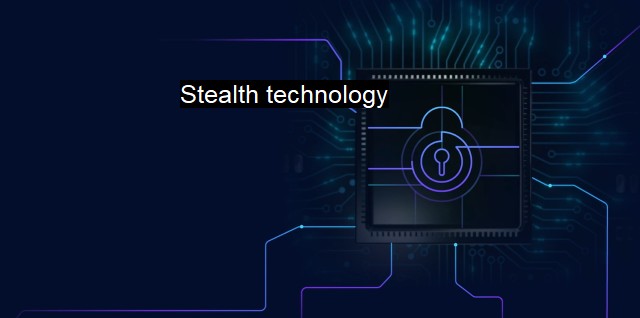What is Stealth technology?
Stealth Technology: Applications and Significance in Military Aviation, Cybersecurity, and Antivirus Systems
Stealth technology in the cybersecurity realm plays a crucial role in concealing the identity of the user or protecting the information or network from cybercriminals. Cybersecurity professionals often see stealth technologies as double-edged swords. On the one hand, these technologies help to shelter legitimate users and their activity online, while on the other hand, they may also enable hackers or viruses to hide their illegitimate activities.Stealth technology typically involves practices and technologies that make it more challenging to intercept, monitor, or track the user's activity or data on the internet. This usually includes using encryption techniques, anonymous browsing tools, or hidden networks, among others. One common example is the 'The Onion Router', known as TOR, a freely available software that allows for anonymous internet use and communication. TOR relies on enclave-oriented scripting and routing to ensure that the exact origin or destination of any data cannot easily be tracked back.
At the same time, stealth technology in cybersecurity can be untrustworthy because of its potential applications for malevolent purposes. stealth viruses are designed specifically to avoid detection by remaining hidden from typical antivirus software. Like a stealth bomber that cannot be detected by radar, a stealth virus hides itself by taking the form of a seemingly benign file or program. Its primary motive is to invade and infect the host system unnoticed until it accomplishes its damaging tasks.
A prevalent form of stealth virus is rootkit technology. Originating from the Unix environment, rootkits are a set of programs that escalate a common user's access rights to the level of an 'administrator' or 'root'. Once a rootkit is installed, attackers practically become the administrators of the infected system. Rootkit technology can hide files, network connections, system processes, or registry entries from detection. Unsurprisingly, this type of stealth virus is inherently difficult to remove.
Another paradigm of stealth technology used in negative elements is advanced persistent threats (APTs). These high-level sophisticated attacks are characterized by their substantial levels of stealth and persistence. APT attackers can gain unauthorized access, remain undetected for an extended period, and steal data in their ongoing planned, and centralized campaign.
Stealth tactics also form significantly advantageous elements for antivirus developers. Modern antivirus systems integrate stealth into their techniques to shield user data. They encrypted the user's data transmissions, scan programs or apps before installation, and use intelligent learning algorithms to categorize and isolate potential threats.
An example that is a testament to this is the end-to-end encryption. With end-to-end encryption, any information transmitted over the internet gets encrypted in a way that only the sender and the intended recipient can access the decrypted information. This system helps in maintaining a secure data transfer mode since no third party, including the service providers, can decrypt the data.
A primary reason for the increasing importance of stealth technologies is the surge in cybercrime rates worldwide. With data becoming an increasingly valuable currency, criminals aim to find new methods for stealing and manipulating it. As such, understanding the uses and nuances of stealth technology is crucial in the combat against cybercrime.
While progress in stealth technology offers increased anonymity, freedom, and security, it's crucial to recognize the potential downsides and abuse relating to it. The wide range of stealth technology applications, from protecting user privacy to aiding cyber-attacks, underscores the necessity for balance and ethical usage. staying vigilant and updated about the latest developments in stealth technology can be a significant step towards more robust cybersecurity.

Stealth technology FAQs
What is stealth technology in the context of cybersecurity?
Stealth technology in cybersecurity refers to techniques and technologies used to conceal or obscure computer systems or activities from detection, analysis, or identification by unauthorized users. It is often used in conjunction with antivirus software to protect against attacks or malware that attempt to bypass or disable the antivirus software.What are some examples of stealth technology used in cybersecurity?
Examples of stealth technology used in cybersecurity include rootkits, spyware, adware, and other malware that can hide themselves from antivirus software and other security measures. Additionally, some antiviruses may use stealth techniques to avoid detection by malware or attackers.Why is stealth technology important for cybersecurity?
Stealth technology is important for cybersecurity because it allows systems and activities to remain hidden or obscured from potential attackers or malware. By preventing detection or identification, stealth technology can help prevent attackers from gaining access to sensitive information or systems, or from disabling antivirus software and other security measures.Are there any risks associated with using stealth technology in cybersecurity?
Yes, there are some risks associated with using stealth technology in cybersecurity. For example, some stealth techniques may be used by legitimate software for benign purposes, but can be exploited by attackers to gain unauthorized access or control over systems. Additionally, some types of malware may use stealth techniques to evade detection and continue to operate undetected on a system.| | A | | | B | | | C | | | D | | | E | | | F | | | G | | | H | | | I | | | J | | | K | | | L | | | M | |
| | N | | | O | | | P | | | Q | | | R | | | S | | | T | | | U | | | V | | | W | | | X | | | Y | | | Z | |
| | 1 | | | 2 | | | 3 | | | 4 | | | 7 | | | 8 | | |||||||